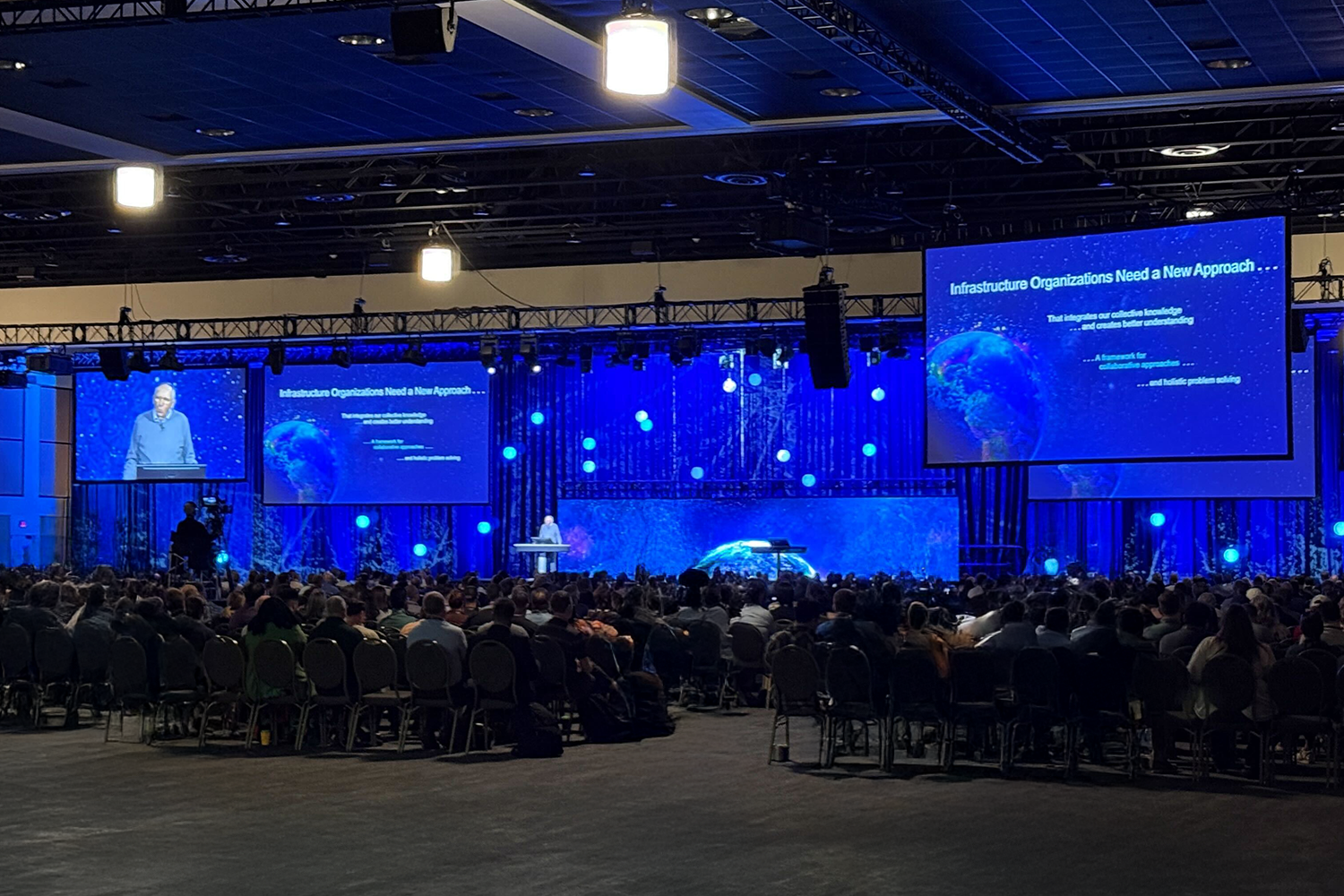The 3-GIS team just spent the week with over 15,000 geospatial professionals from 130-plus countries at the 2025 Esri User Conference.1 The show brought about conversations discussing integration, fiber rollout hurdles, and the always encouraging success stories. From the booth to speaking sessions and side-hall conversations, a few consistent themes emerged: how can we scale networks faster, protect critical assets, and navigate volatile funding with proven, integrated tools. Here’s a look at the biggest insights and standouts from the week.
Why trusted platforms are gaining traction in today’s funding environment
With major infrastructure efforts underway around the globe, one theme stood out: organizations want technology they can trust in the field, not just in a demo. Across telecom, utilities, and government sectors, attendees emphasized the need for solutions that are already proven, platforms that scale reliably, integrate with existing systems, and come backed by long-term vendor support. Whether the challenge is navigating permitting, managing headcount constraints, or accelerating service delivery, decision-makers are leaning toward tools that offer low-friction adoption and consistent, real-world outcomes.
These pressures aren’t unique to one country or region. They’re shared challenges across a global industry, and they set the tone for many of this year’s most talked-about sessions.
Telecom GIS in action: Highlights from the week’s sessions
Esri UC 2025 featured many telco-focused sessions covering everything from permitting and permitting automation to resilience planning and customer service delivery. Across the board, GIS was positioned not just as a mapping tool, but as a foundational system for accelerating network deployment and protecting infrastructure. It was especially rewarding to see members of the 3-GIS team join the conversation, presenting alongside customers and city leaders who are using GIS to solve real world challenges.
How operators are streamlining customer turn-up
In the telecom industry, “customer turn-up” refers to the final steps required to activate service at a new location. While the fiber may be in the ground, delays often occur between planning and activation due to fragmented systems, manual validation, or limited visibility into serviceability. These gaps not only slow delivery timelines but also frustrate customers and teams alike.
That’s the challenge Ed Bagnall, Managing Director of EMEA at 3-GIS, addressed during his session. Telecom providers are increasingly turning to unified GIS-based systems to streamline the final steps of customer activation. By managing location validation, serviceability checks, and project updates in one connected environment, teams can reduce delays, cut down on manual processes, and deliver service with greater confidence. This approach is especially valuable for operators looking to replace legacy tools and eliminate the operational silos that often slow turn-up after construction is complete.
This focus on operational clarity carried over into a second session, centered on protecting underground infrastructure. It’s another area where integrated GIS is making an immediate impact.
How are cities using GIS to reduce fiber strike risk?
As fiber networks expand into more complex urban environments, the risk of damaging underground infrastructure during construction continues to grow. For city planners and telecom operators alike, improving visibility into asset locations and utility coordination has become a top priority, especially as expectations around outage prevention and dig-safe compliance continue to rise.
That was the focus of a session led by Andrew Wilson, Geographic Information Systems Administrator for the City of Hilliard, Ohio, and Andrew Wright, Senior Consultant at 3-GIS. They showed how municipalities and providers can combine live network data with 811 information to better coordinate projects, reduce strike risk, and protect underground infrastructure. For city engineers managing complex urban builds, this level of real-time visibility is no longer a nice to have. It is essential.
Across both sessions, the takeaway was clear: GIS is becoming the operational foundation for how modern networks are built, activated, and maintained.
2025 SAG Award wins highlight real-world GIS impact
Each year, Esri’s Special Achievement in GIS (SAG) Awards recognize a small number of standout organizations, selected from over 350,000 global Esri customers, that are pushing the limits of geospatial technology to solve real-world problems.2
This year, two 3-GIS customers were among the winners. Each represents a different scale, region, and use case, but both show the same commitment to innovation through GIS.
Oman Broadband earns international honors
Esri recognized Oman Broadband (OBB) for building a centralized, GIS-powered platform that provides real-time visibility into the national fiber network. This system is helping the provider cut FTTx timelines by 25 percent, improve field productivity, and drive smarter, data-led expansion as part of Oman’s broader digital transformation strategy.3
See the details on how OBB has modernized its national infrastructure in the full customer spotlight - Oman Broadband customer spotlight

ECC connects the enterprise with a geospatial digital twin
Ervin Cable Construction (ECC) also received a 2025 SAG Award for developing a geospatial “digital twin” that connects planning, permitting, construction, billing, and resource management in one ecosystem. Before this transformation, a billing clerk processed about 150 miles of network annually. With the new Esri-based platform supporting over 70 client projects, some departments have now improved productivity by up to 92 percent.4
Explore ECC’s full story to see how integrated GIS transformed their operations - Ervin Cable Customer Story
Key takeaways for network teams
- Focus on proven results. Buyers and regulators alike are responding more to case studies and real-world outcomes than to roadmap promises.
- Remove the manual steps. Automation is no longer a future upgrade. It is crucial for scaling efficiently and competitively.
- Make resilience visible. Real-time mapping and infrastructure protection tools are becoming baseline expectations in city and utility partnerships.
- Prepare for policy shifts. Federal funding strategies are evolving. Low-risk rollouts with quick time to value will remain a top priority.
Together, these insights underscore what we heard across sessions and conversations: network teams that embrace trusted, well-integrated GIS workflows are best positioned to meet rising expectations without adding risk.
Citations
1 Esri, “Esri User Conference 2025,” https://www.esri.com/en-us/about/events/uc/overview
2 Esri, “2025 Special Achievement in GIS Awards,” https://events.esri.com/conference/sagList/
3 Esri, “Oman Broadband,” 2025 Special Achievement in GIS Award, https://events.esri.com/conference/sagList/index.cfm?SID=8007&fa=Detail
4 Esri, “Ervin Cable Construction, LLC,” 2025 Special Achievement in GIS Award, https://events.esri.com/conference/sagList/index.cfm?SID=8022&fa=Detail


